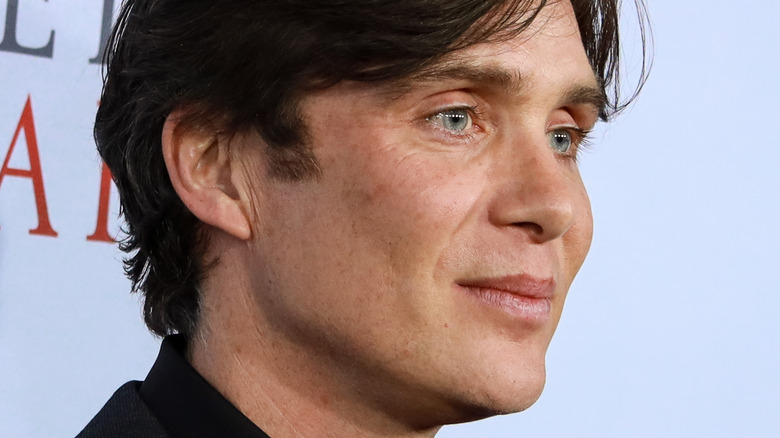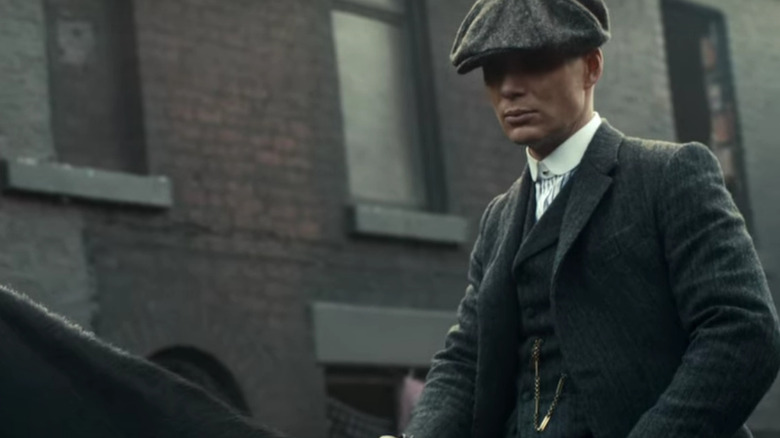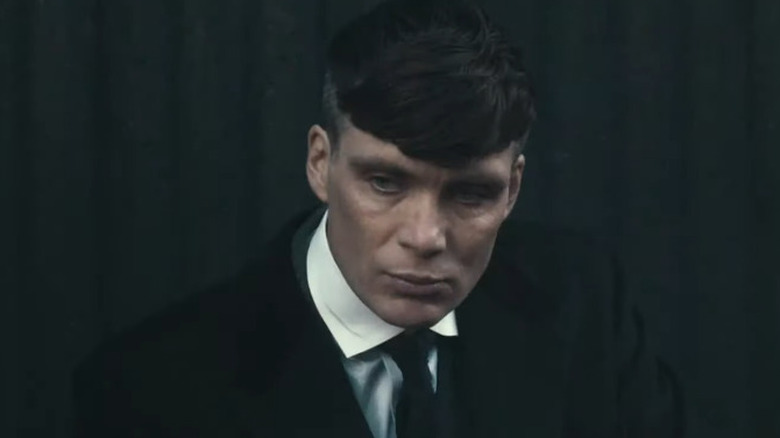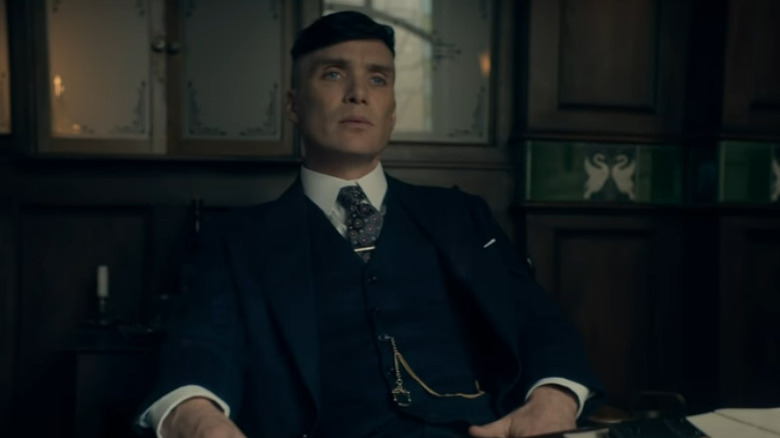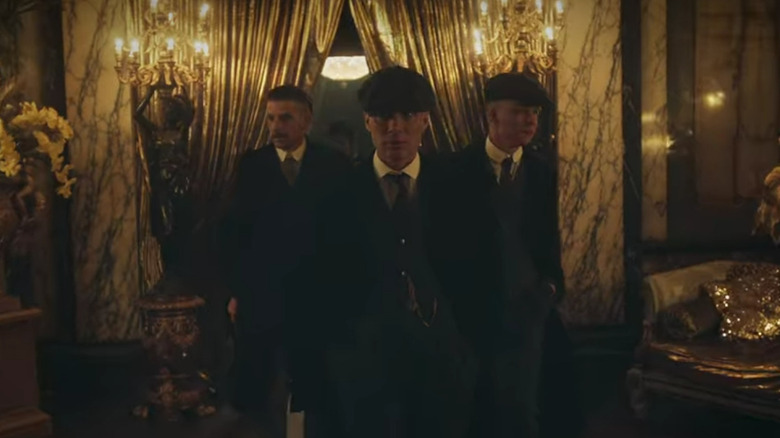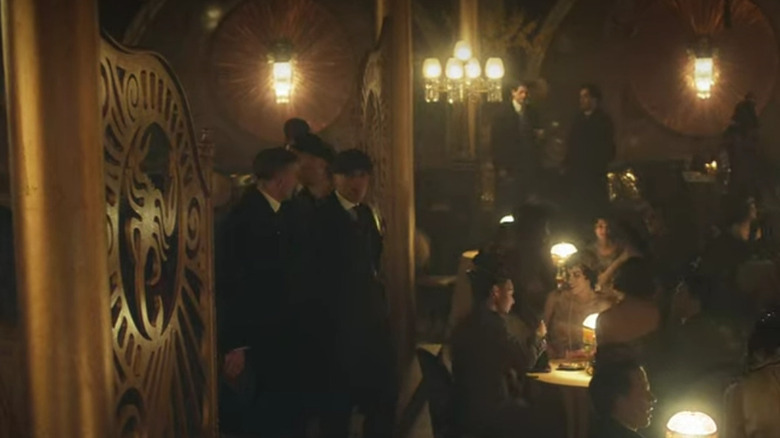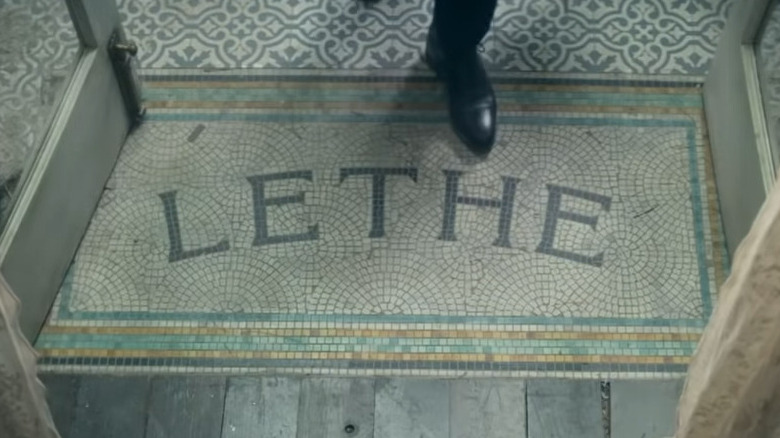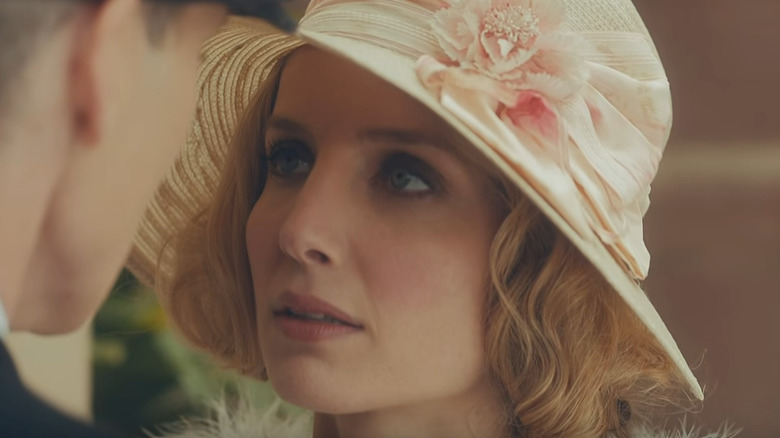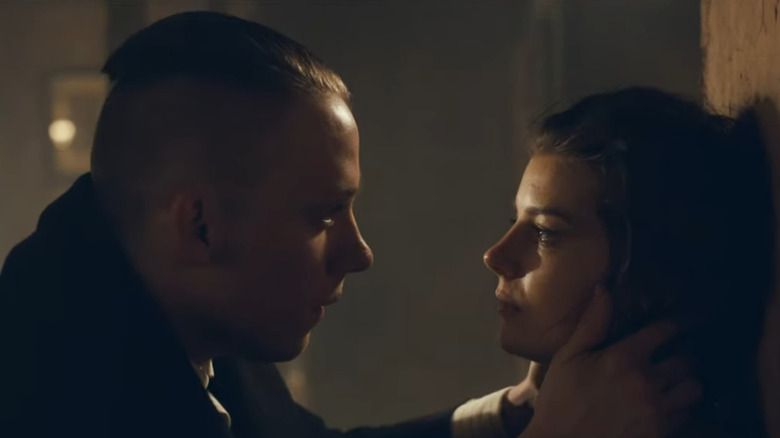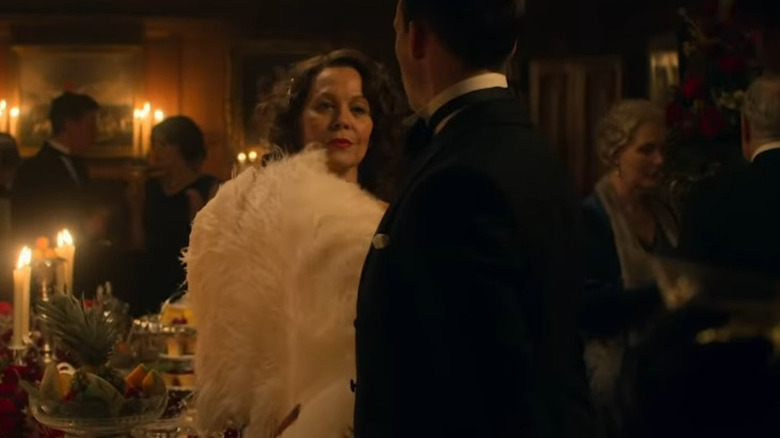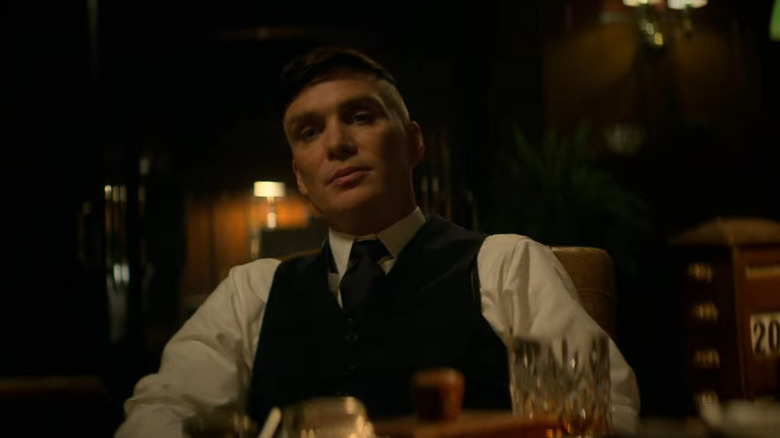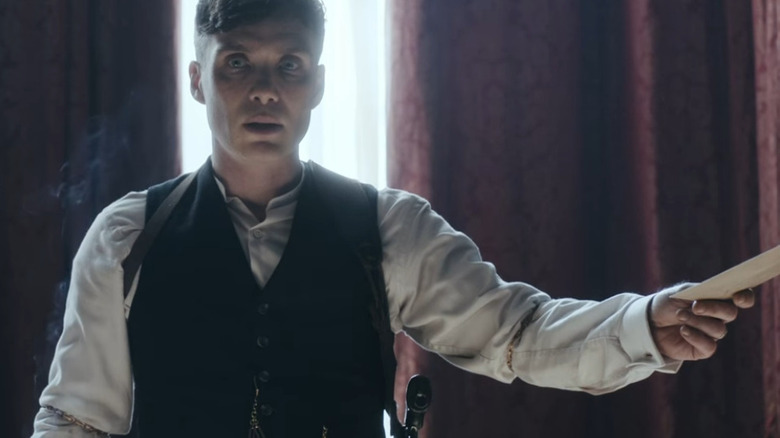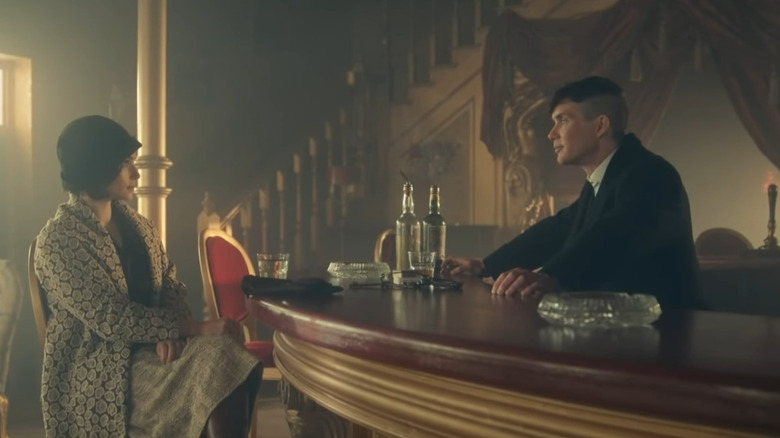Easter Eggs You Missed In Peaky Blinders
When "Peaky Blinders" creator Steven Knight first heard the stories about the titular gang in his hometown of Birmingham, England, he was left with the image of a group of men, all dressed in suits, surrounding a table piled high with money when nobody had any. He knew he wanted to tell their story. That desire blossomed into "Peaky Blinders," a six-season TV series that has gained superstar status since it debuted on BBC Two in 2013. Every element of the show, from its music to its sets, has been chosen carefully. Otto Bathurst, the director of the first season, did away with perfect historical accuracy and instead went for something more cinematic and dramatic. It means that every shot is full of Easter eggs, hidden symbols, or nods to each of the characters. Before you dive into the sixth and final season, learn about the Easter eggs to watch out for.
Black and white horses
The black horse and the white horse make several appearances as Easter eggs throughout the show. Creator Steven Knight chose to use the symbol of his horse because of Tommy Shelby's Gypsy roots. In fact, the opening shot of the pilot features Tommy Shelby (Cillian Murphy) astride a black horse, riding into the hellish center of dark, bleak Birmingham. Knight wanted to create a Western feeling, something that comes up several times within the show.
The black horse serves as a bad omen. In the fifth season, when Tommy puts a gun to his head, he sees the black horse make a reappearance. Contrast that with the white horse, which symbolizes hope and makes an appearance on the Shelby gin label and in the portraits in Tommy's office once he's MP. "He's a man who doesn't forget his roots, no matter how high he rises," said set designer Nicole Northridge (via Den of Geek).
The coats
"Peaky Blinders" led to a frenzy in men's fashion, from the "Peaky" caps and haircuts to the beautifully tailored suits. Tommy Shelby and the boys are always impeccably dressed, likely in homage to their days as soldiers. But the coats have special significance. Stephanie Collie, the costume designer for the show, explained their importance, telling Esquire that they "deliberately used longer coats to get that "High Noon" feeling, when the gangs are walking to each other" and wanted to suggest the image of "gunslingers going against each other, as their coats flap in the wind."
It isn't a coincidence that much of the imagery from "Peaky Blinders" borrows from American stories; Steven Knight has long been fascinated with the mythology of American cowboys. "I'm influenced by Westerns. I like the way that Westerns explore a sort of corrupt chivalry and tell the stories of the outlaw," he's said. "Or of the sheriff fighting the outlaw, but it's about breaking the rules, being beyond the frontier."
The stained glass windows
Ah, the Garrison. This is the pub where so much Peaky Blinders business happens. In the first season, undercover cop Grace gets a job as a barmaid and then starts working for the Birmingham gang. In later seasons, large stained glass windows serve as the backdrop from the goings on inside. These windows include two Easter eggs: The first is a tilt of the cap to Tommy's time in France, when he served as a soldier with the Warwickshire Yeomanry. The symbol for the group — in real life and in the world of "Peaky Blinders" — is a bear chained to a ragged staff.
But Tommy's time with the yeomanry was not a pleasant one. It's clear that Tommy and the men he served with, including his brother Arthur (Paul Anderson), struggle with PTSD — which leads us to the second Easter egg, the rising sun. Set designer Nicole Northridge has explained that this is a gentle nudge reminding audiences of the trajectory of Tommy Shelby's character. There is going to be a new dawn, literally, for the Brummie gangster.
All the gold
For most of the show, the sets use darker colors. Fans and newcomers alike may not realize just how muted the color palette in Birmingham is until the boys go to the Eden Club in London in the second season. The club drips in gold — there's the curling metal work with giant scorpions (which have their own meaning), as well as a ceiling that production designer Grant Montgomery decided to paint gold as soon as he saw the space. The color is now referred to as "Peaky Gold."
Gold makes a reappearance in the final season, when the sight of it becomes linked with death. Tommy's bathroom is covered in black marble shot through with veins of gold. This hints at the death of an important character from tuberculosis. At the time, Danish physicians used gold salts as a treatment, believing that it could kill the bacteria that caused the disease. (It would take a decade for researchers to realize the toxic effects of using gold as a treatment.)
The scorpion fretwork
After putting a bullet in Billy Kimber's head at the end of Season 1, Tommy and the rest of the Shelby clan have their eyes set on a bigger city than Birmingham: London. When Tommy (Cillian Murphy), Arthur (Paul Anderson), and John (Joe Cole) step into the Eden Club, they're met with the sounds of jazz and a room full of opulence, including large metal arches with scorpions etched into them. The scorpions are another Easter egg for fans. They're partly an homage to the silk jacket worn by Ryan Gosling in "Drive," which is itself an homage to a different movie called "Scorpio Rising." In Gosling's movie, he plays a violent killer wearing a white satin jacket with a gold scorpion on the back. Clearly, the parallel to Tommy — an equally stylish and equally violent killer — is an easy one to make.
Even within the show, the scorpion has another meaning. One of the main Big Bads of the season is Darby Sabini (Noah Taylor), the leader of an Italian gang in London. Sabini sees the presence of the Peaky Blinders at his club as a threat, and Tommy and his brothers get into a fight with Sabini and his men, leading to the Birmingham boys taking over the club.
Alfie Solomons' apartment
But Sabini isn't Tommy's only worry in London. He also has to worry about Alfie Solomons (Tom Hardy), the leader of a rival gang. Solomons (who, like Sabini, is based on a real-life gangster of the same name) controls the East End and the docks at Camden Town, as well as the horse races. Since Steven Knight didn't have access to many real-life descriptions of Solomons, he had to get creative.
When building the inside of Solomons' apartment, the set designers wanted to highlight how the gangster straddled two worlds: the living and the dead. The apartment features peeling paint and candles dripping with wax along with taxidermal animals and skulls, lending the space an aura of decay. The other detail that set designers included was the tiles on the floor. The camera glimpses it for only a moment, but it clearly reads LETHE. This is a reference to one of the rivers of Hades; myth says that those who drink from it immediately lose their memories.
Swans
Throughout the first part of the series, Tommy begins a relationship with Grace (Annabelle Wallis), an undercover cop working at the Garrison. When a bullet meant for Tommy hits Grace instead, he's left a widower. As the series continues, Tommy never stops thinking of Grace; images of swans throughout the rest of the series serve as a visual reminder of his late wife. But that doesn't mean the swan is always a symbol of hope. In one episode, the show originally had Tommy looking out over a bridge with a swan swimming underneath it; it became a representation of his suicidal thoughts and his desire to rejoin his late wife in the afterlife. "Grace is calling him home, saying. 'Come and be with me.' It's pretty chilling with the swan being such a beautiful, iconic animal, that it's a metaphor for Grace and Tommy's suicidal thoughts," explained set designer Nicole Northridge.
Esme's clothing
Esme Lee (Aimee-Ffion Edwards) marries into the Shelby family in Season 1, a union arranged by Tommy Shelby. Her marriage to John (Joe Cole), one of the younger of the reigning Shelbys, brokers a peace agreement between their family and hers. While she and John meet on their wedding day, they soon have a true marriage, complete with the couple moving into a house in the countryside, but she longs to return to her previous life as a nomad. After John's death, she takes their children away from Birmingham.
After the first season, Esme starts dressing like the matriarch of the family, Aunt Polly (Helen McCrory), which leads to Polly worrying that Esme will ultimately replace her. McCrory has explained that Polly feels threatened by Esme joining the family. Her mimicking Polly's clothing choices reminds McCrory of the movie "All About Eve," in which a young upstart unseats a reigning queen of Hollywood.
Peacock feathers
Set designers use several animals to symbolize members of the Shelby family. An eagle-eyed viewer will see a lion statue sitting on Tommy's desk when he's MP — a reminder that he wants to be king, and he's not going to let anyone stop him. Another animal used to symbolize the Shelby family is the peacock. Different religions see peacocks as signs of prosperity and good luck, as well as vanity and pride; when it comes to the Shelbys, peacock feathers also tell viewers about the way these gangsters move through the world. Peacocks "make you a little bit nervous in that they're incredibly beautiful but you sense a slight unpredictability and danger," said set decorator Jonnie Mead. Just like the Shelbys.
But peacock feathers also serve as a reflection of the period. The Aesthetic art movement — a movement centered on "art for art's sake" — focused on creating beautiful items and borrowed design motifs from Eastern cultures.
Shakespeare's plays
In many scenes, Tommy Shelby's desk is full of props. This is partly because of Cillian Murphy, who plays the gangster. "Cillian [Murphy] likes a busy desk because he likes to work with props and he always likes to be doing something," explained set decorator Jonnie Mead.
On the desk, viewers can see different books, from Sigmund Freud to Shakespeare's plays. The titles are significant; set designers chose to include "Macbeth" and "King Lear." The former follows one man in his quest for power and his attempt to outrun a prophecy, while the latter focuses on a king who is suspicious of those who try to take his power. Like the Scottish king, Tommy grapples with the question of whether he and his family are cursed by prophecy over the course of the series; he wants to see if he can outrun his fate. In Season 5, he's also wary of anyone trying to unseat him as an MP.
"I think he finds more in Shakespeare than he does in Freud," said Knight. "Analysis isn't enough for him, even though he's so ripe for some Freudian analysis with his mother and all of that. For him, it's not something that you resolve by studying scientifically."
The oranges
In order to understand the Easter egg here, let's take a brief aside into film history. In "The Godfather," oranges become a symbol of impending death. Since Steven Knight and the production team love American cinema — titles like "Goodfellas" and "High Noon" roll off their tongues in interviews — it's no surprise that they make an homage to "The Godfather" in "Peaky Blinders." "Anybody who writes a thing about a crime family that isn't influenced by 'The Godfather' is an idiot, because it's brilliant," argued Knight.
In fact, much of Tommy's office in the second series is meant to mirror Don Corleone's library, and as an added homage to the crime drama classic, the "Peaky Blinders" team intentionally used the oranges to signal death (unlike the original movie, which only used them as a pop of color on set). It was "just a little playful visual smile on this set," said set designer Grant Montgomery.
Mirrors
PTSD takes a central role in "Peaky Blinders." In Season 1, Tommy tries to care for his friend, Danny Whizz Bang, who has violent outbursts. At night, Tommy is haunted by the sounds of digging, echoing his time as a clay digger in France. Steven Knight interviewed Royal Marines who suffered from PTSD to try and understand what the men were going through. "Their minds were so broken," he explained. "I wanted to put all of that into the ['Peaky Blinders'] brothers, especially Arthur [Shelby] and Tommy."
Nicole Northridge wanted to reflect Tommy's attempts to cope with PTSD — and how, no matter how hard he tries, he can't outrun it. In Season 5, she used mirrors in a dressing room to show Tommy's reflection, making him come face to face with himself. "It's just confusion and chaos, which is why we wanted that layering of reflections going on for infinity," said Northridge. "He's finally met the man he can't defeat — or understand — and it's himself."
